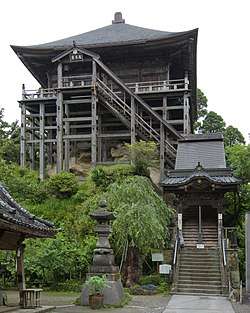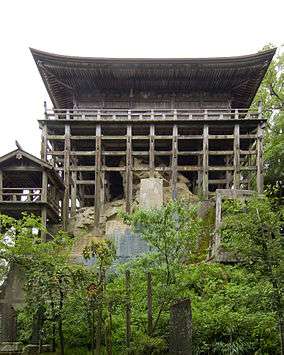Kasamori-ji
Kasamori-ji (笠森寺) is a Buddhist temple located in the town of Chōnan in Chiba Prefecture, Japan. The temple is also called "Kasamori-dera" using the alternate pronunciation of the Chinese character for temple (tera). Kasamori-ji is temple number 31 in the Bandō Sanjūsankasho, or the circuit of 33 Buddhist temples in Eastern Japan sacred to Goddess Kannon. The Eleven-Faced Kannon of Kasamori-ji is only shown to the public in the years of the Ox and Horse in the 12-year cycle of the Chinese zodiac.
| Kasamori-ji 笠森寺 | |
|---|---|
 Kasamori-ji Kannon-dō (笠森寺観音堂), the Kannon Hall of Kasamori-ji | |
| Religion | |
| Affiliation | Tendai |
| Deity | Eleven-Faced Kannon |
| Location | |
| Location | 302 Kasamori, Chōnan, Chōsei District, Chiba Prefecture |
| Country | Japan |
| Architecture | |
| Completed | 784 (traditionally) |
It is part of the Kasamori Tsurumai Prefectural Natural Park.
History
According to tradition the Tendai monk Saichō (767–822) visited the area in 784. Saichō carved a statue of the Eleven-Headed Kannon, and installed the statue in a thatched hut structure. Nichiren is said to have frequently prayed at Kasamori-ji, and an image of him in his quarters at the temple exists.[1] Kasamori-ji appears in both an ukiyo-e woodblock print by Hiroshige II (1829–1869) as part of the series One Hundred Views of the Provinces.[2] Additionally, Matsuo Bashō (1644–1694) wrote a haiku about the temple.[3] A marker with the haiku is located in front of the temple gate.[4]
Kannon-dō
The Kannon-dō hall of Kasamori-ji is the only example of a temple built in the shihōkakezukuri (四方懸造) style; the temple is raised on large stilts on all four sides. The Kannon-dō was built in 1028 by order of the Emperor Go-Ichijō as part of a general revival of the temple. While the other structures of Kasamori-ji have been destroyed by fire three times, the Kannon-dō survived. A document uncovered during a modern repair of the temple indicates that repair work had been previously done to the structure between 1573 and 1596. It is designated an Important Cultural Property of Japan.[5]
Order in Buddhist Pilgrimages
- Bandō Sanjūsankasho
- 30 Kōzō-ji -- 31 Kasamori-ji -- 32 Kiyomizu-dera
Transportation
Kasamori-ji is open every day of the week, 8:00am – 4:00pm. The Kannon-dō can be closed during rain when the stairs become slippery. The temple is accessible from Mobara Station via the JR East Sotobō Line. From Mobara Station the temple is reached by Kominato Bus to the Kasamori Kannon stop.
Gallery
- Kannon-dō of Kasamori-ji
 Kannon-dō of Kasamori-ji
Kannon-dō of Kasamori-ji
External links
- Kasamori-ji (in Japanese)
References
- "Kasamori-dera". Nihon Rekishi Chimei Taikei (日本歴史地名大系 “Compendium of Japanese Historical Place Names”) (in Japanese). Tokyo: Netto Adobansusha. 2012. Archived from the original on August 25, 2007. Retrieved 2012-01-12.
- Item Details for Hiroshige 2 (1826–1869) "Kannon at Kasamori temple in Kazusa province"
- "Kasamori-Kannon". Archived from the original on 2011-11-05. Retrieved 2012-01-12.
- "Kasamori-ji". Nihon Daihyakka Zensho (Nipponika) (日本大百科全書(ニッポニカ) "Great Encyclopedia of Japan (Nipponika)"). Tokyo: Netto Adobansusha. 2012. Archived from the original on August 25, 2007. Retrieved 2012-01-12.}(in Japanese)
- "Kasamori-dera". Kokushi Daijiten (国史大辞典 “Dictionary of Japanese History”) (in Japanese). Tokyo: Netto Adobansusha. 2012. Archived from the original on August 25, 2007. Retrieved 2012-01-12.
[[Category:Buddhist temples in Chiba Prefecture